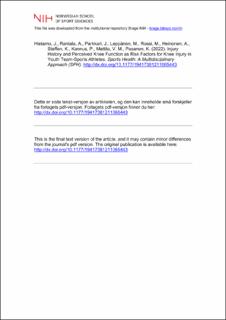| dc.contributor.author | Hietamo, Jussi | |
| dc.contributor.author | Rantala, Anni | |
| dc.contributor.author | Parkkari, Jari | |
| dc.contributor.author | Leppänen, Mari | |
| dc.contributor.author | Rossi, Marko | |
| dc.contributor.author | Heinonen, Ari | |
| dc.contributor.author | Steffen, Kathrin | |
| dc.contributor.author | Kannus, Pekka | |
| dc.contributor.author | Mattila, Ville M. | |
| dc.contributor.author | Pasanen, Kati | |
| dc.date.accessioned | 2022-03-24T11:36:44Z | |
| dc.date.available | 2022-03-24T11:36:44Z | |
| dc.date.created | 2022-02-04T11:16:04Z | |
| dc.date.issued | 2022 | |
| dc.identifier.citation | Sports Health: A Multidisciplinary Approach (SPH). 2022. | en_US |
| dc.identifier.issn | 1941-7381 | |
| dc.identifier.uri | https://hdl.handle.net/11250/2987310 | |
| dc.description | I Brage finner du siste tekst-versjon av artikkelen, og den kan inneholde ubetydelige forskjeller fra forlagets pdf-versjon. Forlagets pdf-versjon finner du på journals.sagepub.com / In Brage you'll find the final text version of the article, and it may contain insignificant differences from the journal's pdf version. The definitive version is available at journals.sagepub.com. | en_US |
| dc.description.abstract | Background: The identification of risk factors for sports injuries is essential before injury prevention strategies can be planned. Hypothesis: Previous acute knee injury and lower perceived knee function measured by Knee injury and Osteoarthritis Outcome Score (KOOS) will increase the risk of acute knee injury in youth team-sports athletes. Study Design: Prospective cohort study. Level of Evidence: Level 3. Methods: At baseline, youth (≤21 years old) male and female basketball and floorball athletes completed a questionnaire on previous acute knee injuries and perceived knee function (KOOS). A total of 211 male and 183 female athletes were followed for an acute knee injury up to 3 years. Unadjusted and adjusted Cox regression models were used in risk factor analyses. Results: In male athletes, previous acute knee injury and lower KOOS Pain, Activities of Daily Living, Sport and Recreation, and knee-related Quality of Life subscale scores increased the risk of acute knee injury in the unadjusted analyses. Adjusted analyses for male injuries were not performed because of low number of acute knee injuries (n = 18). In female athletes, previous acute knee injury increased the risk of acute knee injury when adjusted for athletes’ age and body mass index (hazard ratio, 2.6 [95% CI, 1.3-5.2]). In female athletes, none of the KOOS subscale scores were associated with the increased risk of acute knee injury in the adjusted analyses. Conclusion: Previous acute knee injury was associated with the risk of new acute knee injury in youth male and female athletes. In youth male athletes, additionally, lower perceived knee function in 4 out of 5 KOOS subscale scores were associated with the increased risk of new acute knee injury. | en_US |
| dc.language.iso | eng | en_US |
| dc.subject | sport injury | en_US |
| dc.subject | injury risk | en_US |
| dc.subject | youth sport | en_US |
| dc.title | Injury History and Perceived Knee Function as Risk Factors for Knee Injury in Youth Team-Sports Athletes | en_US |
| dc.type | Peer reviewed | en_US |
| dc.type | Journal article | en_US |
| dc.description.version | acceptedVersion | en_US |
| dc.source.pagenumber | 10 | en_US |
| dc.source.journal | Sports Health: A Multidisciplinary Approach (SPH) | en_US |
| dc.identifier.doi | 10.1177/19417381211065443 | |
| dc.identifier.cristin | 1997732 | |
| dc.description.localcode | Institutt for idrettsmedisinske fag / Department of Sports Medicine | en_US |
| cristin.ispublished | true | |
| cristin.fulltext | postprint | |
| cristin.qualitycode | 1 | |
